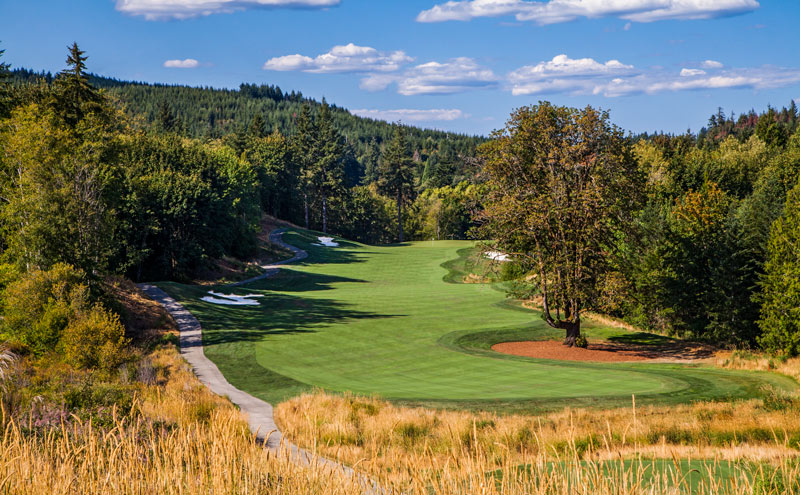
Salish Cliffs Golf Club in Shelton, Wash., is an amenity of Little Creek Casino Resort and opened in 2011. Photo courtesy of Salish Cliffs
Environmental certification and designations are nothing new to the golf industry, but while courses that are Certified Audubon Cooperative Sanctuaries or boast river-friendly status aren’t rare, golf courses that are “salmon-safe” definitely are. One of those, and actually the first to earn the designation, is Salish Cliffs Golf Club in Shelton, Wash.
Located 70 minutes from Seattle, the par-72 layout, designed by Gene Bates, offers world-class golf and stunning Pacific Northwest views, and plays 7,269 yards from the championship tees. The course is part of the Little Creek Casino Resort, owned and operated by the Squaxin Island Tribe. They are a people of the water, and the tribe has treaty rights that include fishing for salmon, which they continue to do.
“Their culture is very salmon-centric,” explains Jeff Dickison, the tribe’s assistant director of natural resources. “They always look at what they do in the context of protecting their resources.”
Right from the grow-in of Salish Cliffs, the tribe wanted to align with an organization that reflected its values. Research led them to Salmon-Safe, a nonprofit based in Portland, Ore., whose mission is to transform land management practices so Pacific salmon can thrive in West Coast watersheds. The group had a long history of working with agriculture, but it was looking to expand its services to other land uses such as parks, college campuses and golf courses. After the two groups connected, they discovered a way to work together.
Salish Cliffs is a trailblazer because it was the first golf course to earn the Salmon-Safe designation. Now, a handful of other courses in the Pacific Northwest have followed its lead in these environmental practices, including nearby Chambers Bay (host of the 2015 U.S. Open), which uses a significant amount of reclaimed water.
Robert Pearsall, Salish Cliffs’ superintendent and a 21-year GCSAA member, arrived at the course prior to the grow-in back in 2009. The 2015 season was one of the driest on record, with two precipitation events — one in late July and one in September — the only things keeping the well at Salish Cliffs from running dry. To conserve water, Pearsall stopped watering the driving range in May, and only irrigated when absolutely necessary.
The 25-million-gallon pond is where all the water on the course is stored. To earn the Salmon-Safe designation, one of the key projects the club embarked upon during the grow-in was building a membrane bioreactor sewage treatment plant for the whole casino resort. This plant treats the water to a reclaimed Class A standard, and Salish Cliffs then uses that water to irrigate the course.
During the grow-in and design, the course also took care to monitor its erosion control, protecting all the watersheds and avoiding the wetland areas on the 320-acre site. The course actually created more wetland areas than previously existed. Salish Cliffs GC also installed a modern, efficient irrigation system, so each sprinkler head can be calibrated based on the amount of moisture in the surrounding turf. Rather than running off into the surrounding creeks, all the drainage on the course flows back into their irrigation pond for reuse.
Pearsall takes pride in the fact that Salish Cliffs is the first golf course in the world to hold the Salmon-Safe designation. There is an exhaustive list of criteria the course must pass and verify, such as whether the course protects the native habitat, manages water runoff, reduces pesticides, and advances environmental practices throughout the region where it is located. He admits it wasn’t easy to set up, and maintaining the status continues to be hard work, but he can’t imagine managing the course any other way.
When other superintendents call Pearsall to ask whether keeping up the Salmon-Safe designation is worth all the extra effort, he says he tells them that, just like anything in life, you have to find a way to make it work.
“There is always a solution,” he concludes. “My brother thinks I always look for challenges. Sure, it was a challenge, but we did it, and it’s been great. I can go to bed at night knowing we’ve done everything to take care of our environment.”
David McPherson is a freelance writer based in Waterloo, Ontario, and a regular GCM contributor.